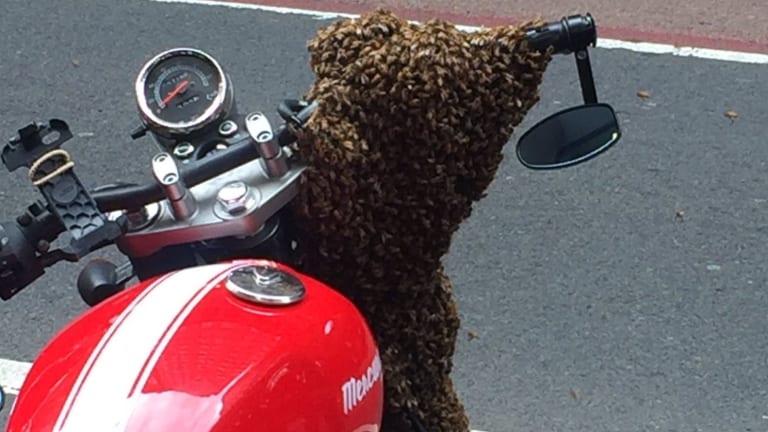Why do bees swarm?
23 Nov. 2018In spring each year, many bee colonies split into two. This is their way of reproducing into larger groups. The original queen leaves the hive with most of the workers (often thousands of individuals) in a swarm to find a suitable location to start a new hive. Usually they will temporarily rest in a clump nearby until a permanent site can be found.
Sometimes they can select the most inconvenient of spots, like this swarm last year in Sydney's CBD that choose this motorbike as their temporary location.
Scouts then fly about looking for a site that is safe, protected and has a volume large enough to contain a hive. Usually they won’t investigate further than about 1 kilometre. The scouts return to the clump and perform a dance to indicate that they have found a good place. The more excited they are about the site, the more excited their dance is. Other scouts examine the site and if most of them also perform an excited dance when they return, the bees will leave their temporary location and head to the new site to set up the hive.
Many home owners become concerned about bees swarming and clumping on surfaces around their home at this time of year, but it’s likely that the bees are only temporary visitors to the property. When they leave the original hive, they have only the food in their stomachs to survive on until they find a new permanent site and start to collect nectar again. So they usually only remain in temporary locations for a few hours and the maximum time is about three days. It’s common to see dead bees on the ground around the clump as some of them will have already expired.
When bees get too close, the worst thing that people can do is try and hose the swarming bees with water, throw things at them or disturb them in anyway. So if clump of bees settles on a surface around your home its best to just leave them alone. Avoid going near them as much as you can and wear shoes when you go outside. Most likely they will move on within a day or two and won’t bother you again.
If the bees do decide to set up a more permanent residence at your home though make sure you contact an expert for help. This will ensure the safety of people and ensure the best outcome for the bees too.
At Termico we work with local Apiarists to relocate and home bees in the Perth suburbs in an effort to slow the drastically declining numbers of this ecologically essential insect. Check out this video of one of our technician's moving a Queen bee and relocating a hive to their new home.
We are Perth's Pest Control experts with over 100,000 West Australians trusting us to keep their homes safe from Pests each year.
to keep their homes safe from Pests each year.
Call us today “We’ll take your call, book you in and turn up on time.” 9443 9451






